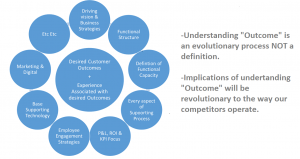
Changing the mindset, one outcome at a time
Customer Outcome Management will fundamentally change the approach you take – to everything.
In my earlier article, I introduced the concept of outcome-based thinking. It’s best illustrated by an example of a product that will be familiar to almost everybody.
Go back to Macworld 2007 when Steve Jobs introduced the first version of what we know as the iPhone. He started by saying that this was going to be a revolutionary year for Apple. He started by telling the Apple employee audience he was introducing three revolutionary products. A revolutionary wide-screen iPod with touch controls, a revolutionary mobile phone and a breakthrough internet communications device. He said it twice again. An ipod, a phone and an internet communications device. An iPod, a phone and an internet communications device. Then he asked the Apple audience “are you now getting it”. This was not three separate devices – this was one device! That was the moment that he took his customers to a completely different outcome. He had moved them from mobile telephony into a much wider domain around lifestyle management. The customer could now use the iPhone to read articles. They could check the weather. They could send emails. They could play games. Of course, this has been hugely enhanced to what we now do with it today. Had he invented the concept? Of course not. The origins of bringing the concept of PDA and telephony together had been introduced 13 or 14 years previously.
What he had done was to create not only a lifestyle management outcome which others were flirting with, but part of the big step forward was making it incredibly easy.
It seems so obvious now because we have been living with device-driven lifestyle management for years. What Apple had done, at the time, was to create a massively enhanced package of outcomes, re-defining “ease of use” and “convenience” along the way. This was way in advance of what was already out there. Sure, the customer had a great experience, but it was the outcomes that made that massive difference and helped to revolutionise communications into what it is today.
This is why I used the analogy of customer experience being akin to icing on a cake. The concept of customer experience without considering outcome does not change things anywhere near enough, which is why we focus on outcomes first and experience associated with those outcomes second. We are now in the era of Customer Outcome Management.
Innovators naturally look at opportunity from a completely different direction. Part of this is looking at what a customer needs/wants and working backwards. Not from a capability perspective and working forward.
Think of the customer outcome framework is akin to peeling an onion. Your understanding deepens as you peel layer after layer. All this thinking is easily learnable, but I believe it goes way beyond customer experience as it is currently practiced.
A more formal definition now probably makes a bit more sense.
Customer Outcome Management is the process of aligning everything you do to the Successful Customer Outcomes plus the experience associated with each outcomes:
For those Outcomes that you have chosen to deliver at a particular time point (this evolves so you competitively stay ahead)
That maximizes the P&L, ROI and every important KPI of the organization
That aligns/harmonises customer to employee outcome, stakeholder outcomes (could be internal or external), social agenda and company outcome (P&L)
This concept impacts how you research, how you develop, what products you build, how you drive your processes and how you define your structures.
This is completely different fromhow we have worked with Customer Experience up until now.
This is a 180-degree shift from where you typically start change.
If the desired outcomes and experience associated with those outcomes is better than any of your competition – guess what – potential customers are going to seek you out, rather than them
This approach impacts revenue, cost, service, ROI in fact every single performance indicator important to the organisation
The bad news is that traditional Customer Experience tools and techniques will NOT help you achieve this!
The good news is, the techniques required to move towards this:
- will identify opportunity ahead of any other Customer Experience techniques currently out there
- are available now,
- are quick to learn
- are easy to understand.
I would go as far to say they are revolutionary.
The great news is within a that within a short amount of time they can be taught.





